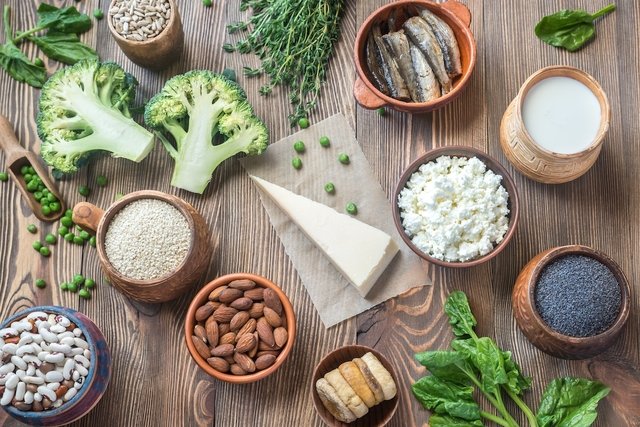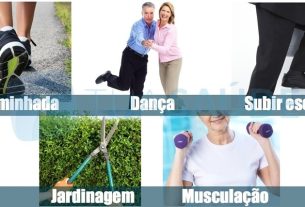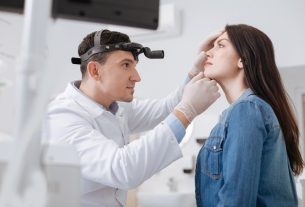The diet for osteoporosis must be rich in calcium, which is the main mineral that forms bone mass, and vitamin D. In addition, magnesium and phosphorus are also minerals that must be ingested regularly and that help to strengthen bones.
Calcium can be found in various foods, such as milk, cheese, almonds, sesame seeds and yogurt. Vitamin D is mainly present in fish, meat and eggs.
In addition to diet, it is also recommended to practice physical exercise regularly, such as running, weight training and walking, as they increase the absorption of calcium in the bones and prevent the loss of bone density.

What to eat
When eating for osteoporosis, it is recommended to prioritize foods rich in minerals, such as:
1. Calcium
Calcium is essential for strengthening, increasing resistance and maintaining bone health, therefore, to help prevent and combat osteoporosis, foods rich in calcium should be included in the diet, including milk and its derivatives, such as cheese and yogurts.
In addition to dairy products, some foods that also have good amounts of calcium are sardines, almonds, salmon, tofu and sesame. Check out a list of foods rich in calcium.
Generally, the recommended amount of calcium is 1000 to 1200 mg per day for adults, but it can vary according to each person, requiring guidance from a doctor or nutritionist to create a balanced and individualized diet.
Watch the video with nutritionist Tatiana Zanin about a diet rich in calcium:
2. Vitamin D
Vitamin D is important for increasing the absorption of calcium and phosphorus in the intestine, helping to strengthen bones and prevent and treat osteoporosis.
Foods rich in vitamin D include fish such as salmon, sardines and herring, cod liver oil, eggs and beef, for example. However, the biggest and best way to produce enough vitamin D for the body is by sunbathing daily for 20 minutes, as the sun’s rays stimulate the production of this vitamin in the skin.
If vitamin D levels are already low or when osteoporosis is already present, the doctor may recommend supplements based on calcium and vitamin D. See the benefits of calcium and vitamin D supplements in osteoporosis.
3. Magnesium
Magnesium is an important mineral for bone health and strengthening, and can be a good ally in the prevention and treatment of osteoporosis. Check out all the properties of magnesium.
This mineral, present in pumpkin seeds, sesame, linseed, chestnuts, almonds, peanuts and oats, for example, acts by converting vitamin D into its active form, as only then will it act properly in the body.
The recommended amount of magnesium per day is 310 to 320 mg for women and 400 to 420 mg for men.
4. Phosphorus
Phosphorus is another important mineral to help strengthen bones, being very useful in the prevention and treatment of osteoporosis, and can be found in foods such as milk, cheese and yogurt, meat, cereals, brown rice, eggs, nuts and fish.
The recommended amount of phosphorus for adults is 700 mg per day and to improve the absorption of phosphorus in the intestine it is important to also consume foods rich in vitamin D.
What to avoid
When eating for osteoporosis, you should avoid consuming foods that reduce the absorption of calcium in the intestine or that increase its excretion by the kidneys, through urine, such as:
- Excessive salt and sodium-rich foodssuch as cubes of meat, sausage, sausage, ham, frozen ready-to-eat food and fast food;
- Caffeinepresent in coffee, black tea, chocolate, green tea and soft drinks;
- Butter and fatty meatsas excess saturated fat reduces the absorption of calcium in the body;
- Excess proteinspresent mainly in meat, fish and chicken.
Furthermore, excess protein increases the elimination of calcium in the urine, reducing its absorption in the intestine, as proteins are normally present in foods that are also rich in iron, a mineral that reduces calcium absorption. Check out a complete list of foods rich in iron.
It is also advisable to avoid consuming foods that are sources of calcium along with foods rich in oxalates and phytates, such as spinach, rhubarb, wheat bran, lentils or beans, for example. This is because when these substances are ingested in excess, they reduce calcium absorption.
Diet menu for osteoporosis
The following table provides an example of a 3-day menu for osteoporosis:
This menu is just a model that may vary depending on each person’s health status and nutritional needs. Therefore, it is recommended to consult a nutritionist to carry out a complete assessment and plan a personalized menu.
See other tips for keeping your bones strong in the video below:

Sign up for our newsletter and stay up to date with exclusive news
that can transform your routine!
Warning: Undefined array key "title" in /home/storelat/public_html/wp-content/plugins/link-whisper-premium/templates/frontend/related-posts.php on line 12
Warning: Undefined array key "title_tag" in /home/storelat/public_html/wp-content/plugins/link-whisper-premium/templates/frontend/related-posts.php on line 13



